
The Intel 80286 is a 16-bit microprocessor that was introduced on February 1, 1982. It was the first 8086-based CPU with separate, non-multiplexed address and data buses and also the first with memory management and wide protection abilities. The 80286 used approximately 134,000 transistors in its original nMOS (HMOS) incarnation and, just like the contemporary 80186, it could correctly execute most software written for the earlier Intel 8086 and 8088 processors.
Turbo Pascal is a software development system that includes a compiler and an integrated development environment (IDE) for the Pascal programming language running on CP/M, CP/M-86, and DOS. It was originally developed by Anders Hejlsberg at Borland, and was notable for its extremely fast compiling times. Turbo Pascal, and the later but similar Turbo C, made Borland a leader in PC-based development.

IBM PC compatible computers are similar to the original IBM PC, XT, and AT that are able to use the same software and expansion cards. Such computers were referred to as PC clones, or IBM clones. The term "IBM PC compatible" is now a historical description only, since IBM no longer sells personal computers after it sold its personal computer division in 2005 to Chinese technology company Lenovo. The designation "PC", as used in much of personal computer history, has not meant "personal computer" generally, but rather an x86 computer capable of running the same software that a contemporary IBM PC could. The term was initially in contrast to the variety of home computer systems available in the early 1980s, such as the Apple II, TRS-80, and Commodore 64. Later, the term was primarily used in contrast to Apple's Macintosh computers.
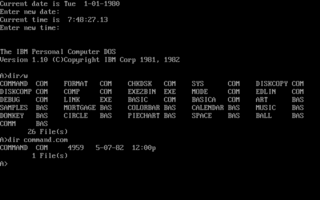
IBM PC DOS, an acronym for IBM Personal Computer Disk Operating System, is a discontinued disk operating system for IBM PC compatibles. It was manufactured and sold by IBM from the early 1980s into the 2000s. Developed by Microsoft, it was also sold by that company as MS-DOS. Both operating systems were identical or almost identical until 1993, when IBM began selling PC DOS 6.1 with new features. The collective shorthand for PC DOS and MS-DOS was DOS, which is also the generic term for disk operating system, and is shared with dozens of disk operating systems called DOS.
Kaypro Corporation was an American home and personal computer manufacturer based out of San Diego in the 1980s. The company was founded by Non-Linear Systems (NLS) to compete with the popular Osborne 1 portable microcomputer. Kaypro produced a line of rugged, "luggable" CP/M-based computers sold with an extensive software bundle which supplanted its competitors and quickly became one of the top-selling personal computer lines of the early 1980s.
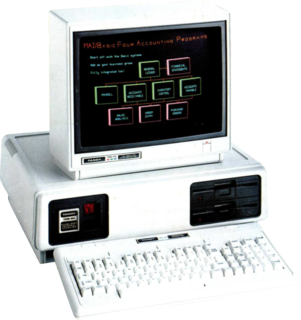
The Tandy 2000 is a personal computer introduced by Radio Shack in September 1983 based on the 8 MHz Intel 80186 microprocessor running MS-DOS. By comparison, the IBM PC XT used the older 4.77 MHz Intel 8088 processor, and the IBM PC/AT would later use the newer 6 MHz Intel 80286. Due to the 16-bit-wide data bus and more efficient instruction decoding of the 80186, the Tandy 2000 ran significantly faster than other PC compatibles, and slightly faster than the PC AT. The Tandy 2000 was the company's first computer built around an Intel x86 series microprocessor; previous models used the Zilog Z80 and Motorola 6809 CPUs.

Multiuser DOS is a real-time multi-user multi-tasking operating system for IBM PC-compatible microcomputers.

The Rainbow 100 was a microcomputer introduced by Digital Equipment Corporation (DEC) in 1982. This desktop unit had a monitor similar to the VT220 in a dual-CPU box with both 4 MHz Zilog Z80 and 4.81 MHz Intel 8088 CPUs. The Rainbow 100 was a triple-use machine: VT100 mode, 8-bit CP/M mode, and CP/M-86 or MS-DOS mode using the 8088.
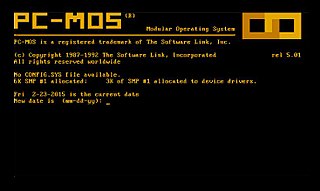
PC-MOS/386 is a multi-user, multitasking computer operating system produced by The Software Link (TSL), announced at COMDEX in November 1986 for February 1987 release. PC-MOS/386, a successor to PC-MOS, can run many MS-DOS programs on the host machine or a terminal connected to it. Unlike MS-DOS, PC-MOS/386 is optimized for the Intel 80386 processor; however early versions will run on any x86 computer. PC-MOS/386 used to be proprietary, but it was released as open-source software in 2017.
Zenith Data Systems (ZDS) was a division of Zenith Electronics founded in 1979 after Zenith acquired the Heath Company, which had entered the personal computer market in 1977. Headquartered in Benton Harbor, Michigan, Zenith sold personal computers under both the Heath/Zenith and Zenith Data Systems names.

Eagle Computer of Los Gatos, California, United States, was an early microcomputer manufacturing company. Spun off from Audio-Visual Laboratories (AVL), it first sold a line of popular CP/M computers which were highly praised in the computer magazines of the day. After the IBM PC was launched, Eagle produced the Eagle 1600 series, which ran MS-DOS but were not true clones. When it became evident that the buying public wanted actual clones of the IBM PC, even if a non-clone had better features, Eagle responded with a line of clones, including a portable. The Eagle PCs were always rated highly in computer magazines.
During the late 1980s, Intel sold two ISA expansion cards named Intel Inboard 386/AT and Intel Inboard 386/PC, which allowed users to upgrade an IBM AT or an IBM PC respectively. The boards allowed users to upgrade their machines' CPU to a 16 MHz 80386 processor. Both variants utilized a ribbon cable which plugged into the computer's original CPU socket on one end and into a socket on the Inboard card on the other end.
SoftPC is a software emulator of x86 hardware. It was developed by Rod MacGregor, Henry Nash & Phil Bousfield, following the founding of Insignia Solutions in 1986 By MacGregor, with "about a dozen people who had left the CAD/CAM workstation specialist Computervision", believing in a market opportunity for an independent CAD/CAM consultancy. Originally a side project, SoftPC quickly became the main focus for the company, running PC software on workstations. Originally developed on SPARCstations, the first customer to license the software was Intergraph whose workstation had a proprietary processor architecture. Available originally on UNIX workstations to run MS-DOS, the software was ported to the Macintosh in 1987, and later gained the ability to run Microsoft Windows software. Besides Mac OS, supported platforms included SGI IRIX, Sun Solaris, HP-UX, IBM AIX, NeXTSTEP, Motorola 88000, OpenVMS on VAX and DEC Alpha systems, DEC ULTRIX, and others.

Following the introduction of the IBM Personal Computer, or IBM PC, many other personal computer architectures became extinct within just a few years. It led to a wave of IBM PC compatible systems being released.
This article presents a timeline of events in the history of 16-bit x86 DOS-family disk operating systems from 1980 to present. Non-x86 operating systems named "DOS" are not part of the scope of this timeline.
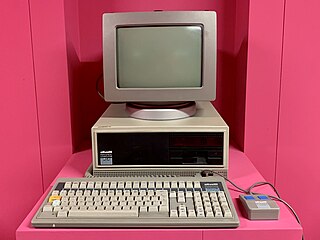
The Olivetti M24 is a computer that was sold by Olivetti in 1983 using the Intel 8086 CPU.

IBM 5550 is a personal computer series that IBM marketed in Japan, Korea, Taiwan and China in the 1980s and 1990s, for business use customers. In Japan, it was introduced in 1983 and promoted as "Multistation 5550 (マルチステーション5550)" because it had three roles in one machine: a PC, a word processing machine which was traditionally marketed as a machine different from a PC in Japan, and an IBM-host attached terminal.
The BT Merlin M4000 was a Personal computer sold by British Telecom during the 1980s as part of the Merlin range of electronic machinery for businesses. It was not developed by BT but was a rebadged Logica VTS-2300 Kennet, and a completely different machine from the Merlin Tonto which was a rebadged ICL OPD. Merlin M4000 was designed as a general purpose computer but was not IBM PC compatible, and so could not run the major business applications around at the time as these were tied to the IBM PC hardware.
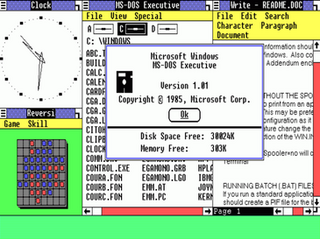
Windows 1.0 is the first major release of Microsoft Windows, a family of graphical operating systems for personal computers developed by Microsoft. It was first released to manufacturing in the United States on November 20, 1985, while the European version was released as Windows 1.02 in May 1986.

MS-DOS is an operating system for x86-based personal computers mostly developed by Microsoft. Collectively, MS-DOS, its rebranding as IBM PC DOS, and a few operating systems attempting to be compatible with MS-DOS, are sometimes referred to as "DOS". MS-DOS was the main operating system for IBM PC compatibles during the 1980s, from which point it was gradually superseded by operating systems offering a graphical user interface (GUI), in various generations of the graphical Microsoft Windows operating system.












